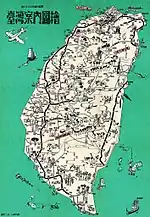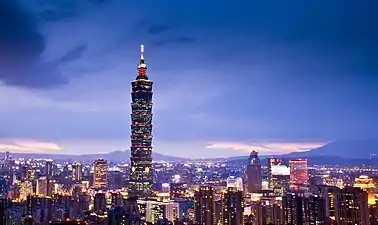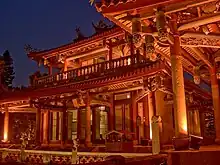Tourism in Taiwan is one of the major industries and contributor to the economy of Taiwan. In 2022, Taiwan received under 900,000 international visitors, down from 11.8 million in 2019.[1] Tourism affairs are managed by the Tourism Bureau of the Ministry of Transportation and Communications of Taiwan.
Tourist destinations
There are numerous attractions in Taiwan. Major national icons or tourist attractions include:
| City / Area | Attraction | Description |
|---|---|---|
| Taipei | National Palace Museum | One of the largest museums in the world holding Chinese artifacts with over 696,000 pieces. The museum was built after the collection was evacuated from mainland China in 1949 to prevent Communist China from controlling and ultimately destroying any artifacts as part of the Cultural Revolution. |
| Taipei | Presidential Office Building, Taipei | The building housing the Office of the President of the Republic of China (Taiwan). It originally housed the Office of the Governor-General of Taiwan when Taiwan was part of the Empire of Japan from 1895 to 1945. |
| Taipei | Chiang Kai-shek Memorial Hall | A Memorial Hall built to honor the late President and Generalissimo Chiang Kai-shek. |
| Taipei | Taipei 101 | Formerly the tallest building in the world from 2004 to 2010. Consisting of 101 floors it is primarily a commercial office building with restaurants, clubs, commercial stores and tourist observatories. |
| Taipei | Shilin Night Market | A night market located in the Shilin District of Taipei, and is often considered to be the largest and most famous night market in the city. |
| Taipei | Mengjia Longshan Temple | One of the oldest temples in Taipei. |
| Hualien | Taroko National Park | One of Taiwan's national parks, with the landmark being Taroko Gorge. |
| Tainan | Fort Zeelandia and Fort Provintia | The oldest city and once an old capital of Taiwan, the city is dotted with ancient temples, shrines and fortress. Tainan is also famous for its traditional Taiwanese cuisine and night markets. |
| Taichung/ Nantou | Sun Moon Lake | A popular scenic spot. The lake is the largest body of water in Taiwan, situated in Yuchi, Nantou, the area around the Sun Moon Lake is home to the Taiwanese indigenous Thao tribe. |
| Kenting | Spring Scream | An annual outdoor music festival held in early April, featuring local and international folk, punk, and rock musicians and artists. |
| Chiayi | Alishan National Scenic Area | A mountainous natural preserve that includes vibrant wilderness, forests, four villages, waterfalls, high altitude tea plantations, and the famous Alishan Forest Railway, and several hiking trails. It is also a famous flower spotting, particularly cherry blossom, destination during spring time. |
| Chiayi | Hinoki Village | A village that was originally the dormitories of the Chiayi Forest division of Forestry Bureau of the Taiwan Governor General Office during the Japanese rule of Taiwan. |
| Tainan | Chihkan Tower | A tower that was built 1653 during the Dutch colonization of Taiwan. |
Tourism statistics
.JPG.webp)
International visitors

The top 12 nationalities of international visitors for tourism purpose (pleasure) are:
| Rank | Country / Territory | 2016 |
|---|---|---|
| 1 | 2,845,547 | |
| 2 | 1,397,233 | |
| 3 | 1,379,233 | |
| 4 | 693,224 | |
| 5 | 339,710 | |
| 6 | 292,240 | |
| 7 | 166,044 | |
| 8 | 110,116 | |
| 9 | 54,987 | |
| 10 | 48,198 | |
| 11 | 36,839 | |
| 12 | 32,868 | |
| Source: Tourism Bureau, Taiwan [2][3][4][5] | ||
The top 12 international visitors in Taiwan for all purposes are:
| Rank | Country / Territory | 2019 | 2018 | 2017 | 2016 | 2015 | 2014 | 2013 |
|---|---|---|---|---|---|---|---|---|
| 1 | 2,714,065 | 2,695,615 | 2,732,549 | 3,511,734 | 4,184,102 | 3,987,152 | 2,874,702 | |
| 2 | 2,167,952 | 1,969,151 | 1,898,854 | 1,895,702 | 1,627,229 | 1,634,790 | 1,421,550 | |
| 3 | 1,758,006 | 1,653,654 | 1,692,063 | 1,614,803 | 1,513,597 | 1,375,770 | 1,183,342 | |
| 4 | 1,242,598 | 1,019,441 | 1,054,708 | 884,397 | 658,757 | 527,684 | 351,301 | |
| 5 | 605,054 | 580,072 | 561,365 | 523,888 | 479,452 | 458,691 | 414,060 | |
| 6 | 537,692 | 526,129 | 528,010 | 474,420 | 431,481 | 439,240 | 394,326 | |
| 7 | 509,519 | 419,105 | 290,784 | 172,475 | 139,217 | 136,978 | 99,698 | |
| 8 | 460,635 | 427,222 | 425,577 | 407,267 | 393,037 | 376,235 | 364,733 | |
| 9 | 413,926 | 320,008 | 292,534 | 195,640 | 124,409 | 104,812 | 104,138 | |
| 10 | 405,396 | 490,774 | 383,329 | 196,636 | 146,380 | 137,177 | 118,467 | |
| 11 | 229,960 | 210,985 | 189,631 | 188,720 | 177,743 | 182,704 | 171,299 | |
| 12 | 136,651 | 128,456 | 117,687 | 106,197 | 90,666 | 88,601 | 72,693 | |
| Grand Total | 11,864,105 | 11,066,707 | 10,739,601 | 10,690,279 | 10,439,785 | 9,910,204 | 8,016,280 | |
| Source: Tourism Bureau, Taiwan [3][4][5] | ||||||||
In 2022, as a result of the COVID-19 pandemic, Taiwan received fewer than 900,000 international visitors.[1] To encourage more tourists, selected participants from Canada, the United States, Japan, Slovakia, France, the Netherlands, South Korea, Vietnam, Thailand, Malaysia, India, and Israel were invited in 2023 to promote Taiwan on their social media pages.[6] The Taiwan Tourism Bureau also planned to offer monetary "tourist cards" to visitors from certain countries, offering discounts on travel and accommodation.[1]
Types of tourism
Tourism in Taiwan is limited to business, pleasure, visiting relatives, conferences, study, exhibitions, medical treatment and others.[7]
There has been a surge in tourism numbers noticeably around election time in Taiwan, especially tourists from China.[8] However, tourists from China have declined significantly since President Tsai Ing-Wen took office in 2016.[9] Tsai is a member of the Democratic Progressive Party, which the Chinese Communist Party opposes.[9] Therefore, the Chinese government has reduced the number of travel visas issued to its citizens to visit Taiwan.
In 2018 TreeHugger ranked Taiwan the #1 agritourism destination in the world.[10]
Domestic tourism
In 2015, 87% of Taiwanese had domestic travel for their tourism activities, in which the Kenting National Park became their most favorite destination. They spent an average of NT$9,323 per capita for each vacation, which was mainly for accommodation expenditure.[11]

Tourism revenue
The 2013 annual income for Taiwan from tourism-related industries topped at NT$366.8 billion (US$12.3 billion), an increase of 4.7% from the previous year. The average daily spending of each tourist in 2013 was US$224.07, a decrease of 4.37% from the previous year.[12]
In 2015, total revenue from tourism amounted US$14.39 billion, with an average daily spending by each visitor of US$208.[13]
Stay duration
In 2015, the average length of stay for each tourist visiting Taiwan was 6.63 nights.[13]
UNESCO status
Taiwan has yet to nominate possible inscriptions in any UNESCO networks, such as UNESCO Intangible Cultural Heritage Lists, World Heritage List, World Network of Biosphere Reserves, Creative Cities Network, and Global Geoparks Network, due to China's rejection of the country's entrance to UNESCO.[14] However, in order make use of the conservation concepts achieved by the UNESCO networks, the Bureau of Cultural Heritage under the Ministry of Culture began in 2002 to compile a list of potential world heritage sites in Taiwan with currently 18 entries.[15]
Infrastructure
International airports
Tourists mainly arrive by air and Taoyuan International Airport serves as the most popular airport bringing international tourists into Taiwan as it is the largest airport in Taiwan and important regional hub. Other major airports in Taiwan which facilitate international visitors include Kaohsiung International Airport servicing southern Taiwan, Taichung Airport servicing central Taiwan and Taipei Songshan Airport servicing central Taipei.
Public transport
Tourists are able to travel around the island by using a wide variety of transportation modes. The most popular ways are Taiwan High Speed Rail, conventional trains on Taiwan Railways, and the metropolitan cities' metro systems such as the Taipei Metro, Taoyuan Metro, and Kaohsiung MRT as a result of multiple transport hubs which allow travellers to easily transfer between the different systems. A tourist bus called "Taiwan Tourist Shuttle"[16] and taxis are also popular.
Gallery


 Jiufen Old Street, New Taipei City
Jiufen Old Street, New Taipei City


See also
References
- 1 2 3 Fernandez, Celia (6 March 2023). "Taiwan is paying tourists to visit—here's what you need to know". CNBC. Retrieved 9 January 2024.
- ↑ "Annual reports". Taiwan Tourism Bureau. Retrieved 24 February 2017.
- 1 2 "Tourism Bureau, M.O.T.C. Republic of China (Taiwan) Visitor Arrivals by Residence, 2014". Retrieved 17 June 2016.
- 1 2 "Tourism Bureau, M.O.T.C. Republic of China (Taiwan) Visitor Arrivals by Residence, 2014". admin.taiwan.net.tw. Retrieved 2015-07-05.
- 1 2 "Tourism Bureau, M.O.T.C. Republic of China (Taiwan) Visitor Arrivals by Residence, 2013". admin.taiwan.net.tw. Retrieved 2015-07-05.
- ↑ "Groups selected to spend a night at Taiwan's Presidential Office - Focus Taiwan". Focus Taiwan - CNA English News. 2023-08-14. Retrieved 2023-11-30.
- ↑ "Tourism Bureau, M.O.T.C. Republic of China (Taiwan) Visitor Arrivals by Purpose of Visit, 2014". admin.taiwan.net.tw. Retrieved 2015-07-05.
- ↑ "Taiwan: Chinese tourists flock to see elections". BBC News. 25 November 2014. Retrieved 2015-07-05.
- 1 2 Horton, Chris (2017-05-17). "With Chinese Tourism Down, Taiwan Looks to Lure Visitors From Southeast Asia". The New York Times. ISSN 0362-4331. Retrieved 2018-02-02.
- ↑ Lew, Josh. "Top 8 Agritourism Destinations in the World". www.treehugger.com. TreeHugger. Retrieved 17 February 2021.
- ↑ "Nearly 90% of Taiwanese have staycations last year: poll - Economics - FOCUS TAIWAN - CNA ENGLISH NEWS".
- ↑ "Tourism income reaches record high in 2013: bureau - The China Post". chinapost.com.tw. Retrieved 2014-08-22.
- 1 2 "Taiwan's tourism revenue fell in 2015 despite higher arrivals: DGBAS - Economics - FOCUS TAIWAN - CNA ENGLISH NEWS".
- ↑ "Ministry of Culture-Potential World Heritage Sites in Taiwan". english.moc.gov.tw. Archived from the original on 2018-04-18.
- ↑ Bureau of Cultural Heritage. "Potential World Heritage Cites in Taiwan". Retrieved April 18, 2020.
- ↑ Taiwan Tourist Shuttle
